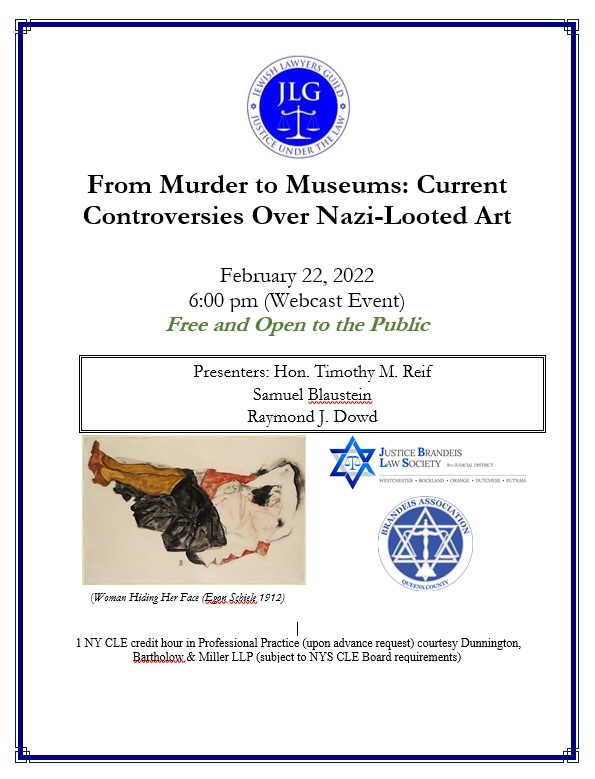
German Version below!
You can register here for this ZOOM event
The event starts on
February 22, 2022 at midnight MET
in English language
By a 5 judge Senate of the Court of Appeals of the State of New York, on Dec. 13, 2018, the June 11, 2018 first instance decision by the SUPREME COURT OF THE STATE OF NEW YORK COUNTY OF NEW YORK District of New York was affirmed by Judge Charles E. Ramos.
The decision by Judge Charles E. Ramos granted the surrender action for wrongful
-Deprivation of Possession and
-appropriation
brought by the heirs of Fritz Grünbaum against the art dealer Richard Nagy, London on Nov. 16, 2015.
The factual issue is thus closed and the ownership rights of the heirs of Fritz Grünbaum over the artworks of Egon Schiele, namely.
1)JK 1101 Model hiding her face (Woman hiding her face) and
2) JK 888 Woman with black pinafore (Woman in black Pinafore)
was thus confirmed.
In another decision dated November 30, 2021, the SUPREME COURT OF APPEALS, FIRST DEPARTMENT awarded the heirs of Fritz Grünbaum approximately $678,000 in damages in interest for the seized property.
By petition dated Feb. 4, 2022, art dealer Richard Nagy requested permission from the Court of Appeals of the State of New York to appeal to it for review of previous decisions unfavorable to him.
A decision on this request is pending.
The law firm
DUNNINGTON BARTHOLOW & MILLER LLP
230 Park Avenue, 21st Floor
New York, New York 10169
Telephone: +1.212-682-8811
Email: rdowd@dunnington.com
now invites you to participate in the above free ZOOM event.
The event will feature The Hon. Timothy Reif (U.S. Court of International Trade) as he recounts the exceptional talent, courage and kindness of his “great-uncle” Fritz Grünbaum — among the most notable cabaret artists, film stars and entertainers of the 1920s and 1930s — his murder in the Dachau Concentration Camp and the theft of Grünbaum’s art collection, including 81 works by the artist Egon Schiele.
Samuel Blaustein will describe his dramatic role in persuading a judge to let us seize of two stolen Egon Schiele paintings spotted at the Park Avenue Armory’s Salon+Art Show, November 2015 and how we secured the artworks at JFK airport where they were bound for London.
Attorney Raymond Dowd will speak about current case law, the impact of the 2016 HEAR Act on New York’s statute of limitations, obstacles facing legal practitioners in pursuing restitution claims, and the outlook for the future of restitution claims.
We wish you an interesting event!
Sie können sich hier für diesen ZOOM Event anmelden
Die Veranstaltung beginnt am
22. Februar 2022 um 24.00 Uhr MET
und ist in Englischer Sprache
Von einem 5 Richter Senat des Court of Appeal des Staates von New York wurde am 13.12.2018 die erstinstanzliche Entscheidung vom 11. Juni 2018 vom SUPREME COURT OF THE STATE OF NEW YORK COUNTY OF NEW YORK Bezirk New York durch Richter Charles E. Ramos bestätigte.
Die Entscheidung von Richter Charles E. Ramos gab der Herausgabeklage wegen widerrechtliche
-Besitzentziehung und
-Aneignung
statt, eingebracht von den Erben von Fritz Grünbaum gegen den Kunsthändler Richard Nagy, London am 16.11.2015.
Die Sachfrage ist somit abgeschlossen und die Eigentumsrechte der Erben von Fritz Grünbaum über die Kunstwerke von Egon Schiele, nämlich
1)JK 1101 Model das Gesicht verbergend (Woman hidingher face) und
2)JK 888 Frau mit schwarzer Schürze (Woman in blackPinafore)
wurde somit bestätigt.
In einer weiteren Entscheidung vom 30.11.2021 sprach derSUPREME COURT BERUFUNGSINSTANZ, ERSTE ABTEILUNG den Erben von Fritz Grünbaum ca. 678 000 $ an Schadenersatz an Zinsen für das entzogene Vermögen zu .
Mit Eingabe vom 4.2.2022 ersuchte der Kunsthändler Richard Nagy den Court of Appeal des Staates von New York um die Erlaubnis diesen zwecks Überprüfung der bisherigen für ihn ungünstigen Entscheidungen anrufen zu dürfen.
Eine Entscheidung über dieses Ersuchen ist ausständig.
Die Rechtsanwaltskanzlei
DUNNINGTON BARTHOLOW & MILLER LLP
230 Park Avenue, 21st Floor
New York, New York 10169
Telephone: +1.212-682-8811
Email: rdowd@dunnington.com
Lädt sie nunmehr ein am oben ersichtlichen kostenlosen ZOOM Event ein.
Bei der Veranstaltung wird Richter Timothy Reif (U.S. Court des internationalen Handels) über das außergewöhnliche Talent, den Mut und die Freundlichkeit seines “Großonkels” Fritz Grünbaum – einer der bekanntesten Kabarettisten, Filmstars und Entertainer der 1920er und 1930er Jahre -, seine Ermordung im Konzentrationslager Dachau und den Diebstahl von Grünbaums Kunstsammlung, darunter 81 Werke des Künstlers Egon Schiele, berichten.
Rechtsanwalt Samuel Blaustein wird seine dramatische Rolle bei der Überzeugung eines Richters beschreiben, der die Beschlagnahmung der zwei geraubten Egon-Schiele-Gemälde erlaubte, die im November 2015 bei der Salon+Art Show in der Park Avenue Armory entdeckt wurden, und wie die Kunstwerke am JFK-Flughafen sicher gestellt wurden, wo sie für London bestimmt waren.
Rechtsanwalt Raymond Dowd wird über die aktuelle Rechtsprechung, die Auswirkungen des HEAR-Acts von 2016 auf die Verjährungsfristen in New York, die Hindernisse, mit denen Juristen bei der Verfolgung von Restitutionsansprüchen konfrontiert sind, und die Aussichten für die Zukunft von Restitutionsansprüchen sprechen.
Wir wünschen Ihnen eine Interessanten Veranstaltung, auch wenn diese für uns zu mitternächtlichen Stunde stattfindet


 Egon Schiele, Self Portrait 1914
Egon Schiele, Self Portrait 1914




